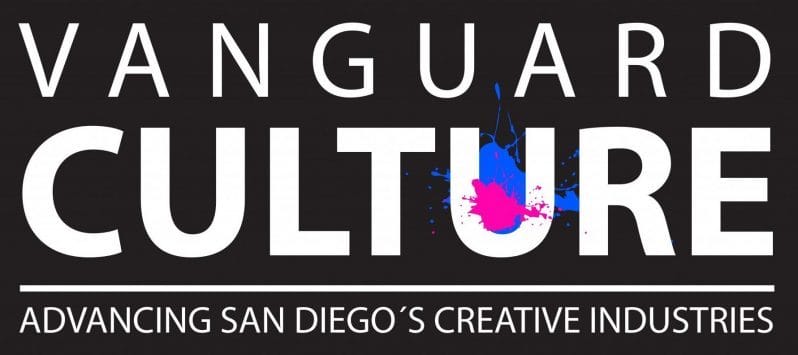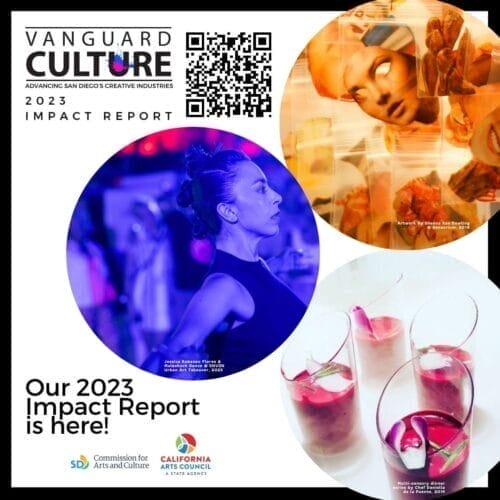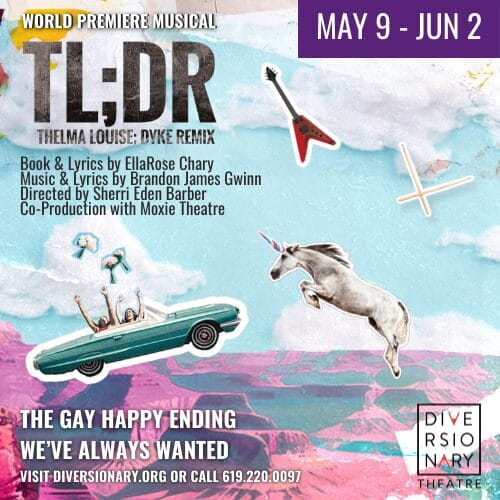By Justin Duyao
February 11, 2023

Armando de la Torre’s latest site-specific project, On the Blue Line, is a colorful and thought-provoking homage to the San Diego trolley line that stretches as far north as the University of California, San Diego (UCSD), in La Jolla, and as far south as the U.S./Mexico border. On view at the Athenaeum Music and Arts Library from Feb. 11 to May 5, 2023, On the Blue Line incorporates found objects, recycled cardboard and wood, as well as sound and Photography elements to investigate the vast distance between promises of opportunity and the socioeconomic barriers that seem always to stand in the way.
Through rich symbolism and metaphor, de la Torre weaves together fragments and echoes of the largely invisible communities of San Diego, including among them the low-income workers who use the blue line to commute for work, as well as the countless individuals who saw the extension of the blue line into La Jolla as an opportunity to get a degree and make a better life for themselves—only to realize that lasting, structural change doesn’t come about that easily.
In our conversation with de la Torre, excerpts of which have been included below, the “director, writer, and artist” sheds light on the importance of this project to him, the ways it resonates with his own experience growing up in San Diego, and his dreams for the future of the city he calls home.
Don’t miss On the Blue Line, on view in the Catherine and Robert Palmer Gallery at the Athenaeum Art Center during open gallery hours:
- Tuesdays – Saturdays from 11 a.m. to 4 p.m.
- Every second Saturday from 5 to 8 p.m., during the Barrio Art Crawl
- OR by appointment.
Vanguard Culture: Tell me about On the Blue Line. I’d love to hear you describe the project in your own words.
Armando de la Torre: On the Blue Line is an idea I’ve been realizing in different capacities, over the years. It’s an expansive idea that can be used in different ways. It started by teaching young kids about their stops to help them know what the next trolley line is en route to Father Joe’s. I had each of them come up with ideas for melodies and songs. That’s how it started.
I used it again in collaboration with the music department at UCSD. But the idea has always been about two points. One, seeing San Diego—specifically the South Bay—from the perspective of somebody that grew up here, an objective perspective of how we experienced San Diego, in the past, and how it’s no longer that San Diego. Beyond that, the trolley is a metaphor for a lot of things: the blue line, as well as the “blue collar” workforce that uses the line to commute into San Diego for work.
I’ve seen people commute to community college, and then I see very interesting kids and young people who end up working at 7-11 down the street. Somehow, in the trolley, you don’t seem to know there’s anything that’s possible for you, which is ironic, because the trolley is supposed to expand the possibilities of opportunities as the new line goes to UCSD, hoping to expand potential opportunities for people. That is true, but opportunities don’t just happen on their own. When you’re up against structural limitations, it’s understood that progress doesn’t easily and smoothly happen.
These are also visual ideas. I’m looking at the environment. As artists, we pay attention to the environment. For this idea of the trolley, I get to focus my idea on developing a narrative. I’m making a trolley that’s 20 feet long and made of cardboard. I borrow ideas from the puppetry world—because I perform with the San Diego Guild of Puppetry—and I’m using these traditions of small theater and expanding them to make a large, site-specific piece. So there will be a cardboard façade that looks like a trolley with a mountain in the back that represents the Chula Vista mountains and a hawk or an osprey that catches a fish.
Together, these things create an interesting picture. You can create really complex meaning from symbology. That’s the thought behind my composition—nature and cityscape, all within the metaphor of a trolley that’s supposed to go somewhere but doesn’t always.
Creating this scene is allowing me to be my own director of my own play. I can tell the story, and I can evolve this narrative. It also gives me an opportunity to be in a position to make creative choices, which is what we all want.
Part of the plan is to go out and photograph people in and around the trolley. It could give me something interesting—but I don’t know. There are so many potential stories to tell here. But the core idea is to highlight people who are trying, somehow, to escape these structural boundaries and find opportunities for themselves. Life is hard! And it’s even more difficult for people with fewer means. The city tries to be friendly and humane; but for many, it’s a struggle. Let’s not forget that we live on the border. There’s a lot of struggle here. A lot of injustices. The resources are controlled by very few.
My piece hopes to tell a story, in the most simple and direct way that I know. By making a piece completely out of cardboard, at the end of the exhibition, I can just break it down and recycle the materials.
I love this metaphor that you use with the trolley line to talk about people yearning to journey to a better place in life. I also know that your desire in your previous work has been to bring together several different communities, in order to experience the same story.
How do you expect different audiences to interact with this piece? For someone that grew up living on the U.S./Mexico border, like you did, I’m sure it will resonate powerfully. But for San Diego residents that have never been to Tijuana or even tried to venture that far south, I’m curious what you hope those people will take away?
That’s a great question. For one, for an artist to develop their voice requires immense support from the community—both giving support and receiving support. From a narrative perspective, the question is: How do we learn to tell our stories? How do we communicate so people on the outside can understand how we experience San Diego?
When I fly into San Diego, I want the city to reflect my experience of it. It never does, which makes me wonder… Why is San Diego not reflecting the people who live here? When did Mexican communities become so invisible? When you’re flying into one of the largest cities on the border, one that has a beautiful bi-national relationship with Baja, one that’s right next door to Tijuana and Ensenada—there’s an immensely unique diversity here. So why doesn’t the city reflect that better?
I think that’s our responsibility, to communicate who we are, from the perspective of people that live in San Diego.
I can tell that the performative aspect of this project really animates the story you’re trying to tell, it completely brings it to life. Of course, you work in a lot of different mediums, from performance art, puppetry, sound and video art to site-specific installations. I’m wondering what draws you to site-specific installations?
Any anthropologist will tell you that, if you’re engaged with a location, there are always nuances that make that place interesting. All you have to do is pay close attention. Barrio Logan, for example, is experiencing the same things today that are happening in so many other developing cities across the country. You can call it many things. I’m not going to use the word “gentrification,” [both laugh] which can be one of the most overused ideas that nobody actually understands. It’s a very complicated concept. Urban communities are very complicated. But I’d say one thing in Barrio Logan is clear.
The scarcity of real estate combined with the demand for housing near beautiful coastal areas has put a strain on San Diego. Southern California, really, is experiencing a housing crisis. There just isn’t enough space. And the people with more money are encroaching on a very historically Mexican community to find it.
From an artistic perspective, I’m trying to find a theme to locate in Barrio Logan, one that isn’t anything other than my truth. I want to tell an objective truth that reflects the San Diego that I know, however it’s a very complex story.
It is complex. But I think the story that you’re telling will speak to that complexity. A lot of people will see growth and, in your words, development, as this “grass is greener” story. But the other side of that is always there—it’s a story that never gets told.
Additional Information:
- When: Opening: Saturday, February 11, 5 p.m. (during the Barrio Art Crawl)
- Where: Athenaeum Art Center – 1955 Julian Avenue San Diego, CA 92113
- What: On the Blue Line







